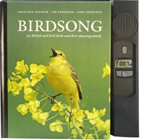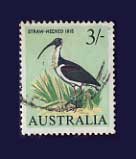Books on Animals
Birdwatching and bird biology
If you want to buy a book, clicking on the book cover will take you directly to that book on the Amazon.co.uk web site.
See also:
- Advice: bird watching in Spain
- Books on the parrot family
- Books on poultry: chickens, ducks etc.
- Books on falconry and birds of prey

Birdsong: 150 British and Irish birds and their amazing sounds
Birdsong: 150 British and Irish Birds and Their Amazing Sounds, is a book which will appeal for people who like to watch birds in their gardens, and who travel by car to see birds. It is too bulky to carry if you are walking, but has the great advantage that you can listen to birds out in the open, with no need for a CD player. The book is well illustrated, so you can identify birds by appearance as well as by sound. The 150 birds include many birds of prey, as well as sea birds, and common garden birds, including migrants. There is a lot of information on when, and why birds sing, which helps with understanding bird behaviour. Sometimes their songs are to attract a mate, other times they want to see off intruders in their territory, for example.
Birdsong is not quite as comprehensive as the RSPB Complete Birds of Britain and Europe, nor is the recording quality of Birdsong quite as good, however, it does offer a deeper understanding to why birds sing, and you can use it out of doors, so it is a very useful supplement to the RSPB guide. It's also handy if you don't own a CD player, because it is easy to use, in fact much easier than a CD player if you want to pick and choose the songs you listen to. Great fun for people who want to know more about Birdsong.

Where to Watch Birds in Southern and Western Spain: Andalucia, Extremadura and Gibraltar
This guide covers some of the richest birdwatching territory in Europe, both coastal regions, and some of the less well known inland parts of Spain. Andalucia has long fascinated Britons, following in the footsteps of Gerald Brenan.
Extremadura is well worth exploring during the spring and autumn, though is best avoided in the high summer due to the intense heat! Extremadura is a region of Spain which is rich in wildlife, and is of especial interest to those who love birds of prey. The terrain includes mountains, plains, arid areas and rivers, forests and bleak, sun-scorched expanses which seem incapable of sustaining life, and yet, if you look upwards, you can see hovering birds of prey. Village rubbish tips are often good birdwatching sites, as are some of the more breathtakingly beautiful mountainous locations. Both authors live in Spain, and their local knowledge and enthusiasm shine through as they guide readers on a fascinating journey round the south and wild west of Spain.
Collins Bird Guide, Second edition edition (7 Jan 2010)
This field guide has become a classic, with its well written descriptions and illustrations that are beautiful as well as informative. It is a good introduction for anyone you might want to turn onto bird watching, as well as an invaluable guide for experienced birders.
The text is a little crammed, and you might need a magnifying glass for some of the text if your eyesight is not as good as it was! The book is designed to be taken on holiday, rather than sitting on a coffee table, so it has to be compact, and it will enrich the holiday of anyone who uses it.

The Zebra Finch: A Synthesis of Field and Laboratory Studies
Zebra finches are tough little birds which are found in Australia and parts of Indonesia. They became popular cage birds in Europe in the 19th century, and were then taken up by laboratories researching bird behaviour and other aspects of biology. Richard Zann is a great admirer of zebra finches, and his affection for these birds is evident in his book, which brings together studies on pet, laboratory and wild zebra finches.
'The Zebra Finch' is a serious academic work, which is nevertheless accessible to hobbyists who simply like zebra finches. The charming illustrations of Michael Bamford are both informative, and have that 'aah' factor. Non-biologists who read New Scientist for pleasure should have enough knowledge to understand the text, though you may need to resort to a dictionary of biology now and then. It is definitely worth persevering if you keep zebra finches. There is a lot of useful material on bird behaviour, for example how zebra finches court and communicate with each other, which can greatly add to the pleasure of keeping these birds. This is an especially useful book for anyone who wants to breed zebra finches, because of the wealth of information on how the birds breed in the wild, which can help keepers to create ideal conditions for their captive zebra finches. There are also useful appendices, for example on colour morphs found in domesticated zebra finches, seeds eaten by wild zebra finches, and zebra finch body languge and calls. There's an extensive bibliography, and an author and a subject index. It's quite a pricey book, but well worth the investment for people who keep zebra finches, because it's a text that you are likely to turn to again and again

Bird Migration: A General Survey (Oxford Ornithology S.)
This is a revised, updated and expanded version of Peter Berthold's classic study which first came out in 1990. It brings together work on different aspects of bird migration, and is quite easy to read, even for people who aren't biologists but just find the topic fascinating. As late as the 18th century, some experts believed that swallows went into swamps for the winter, coming out into daylight to fly in the spring. Today we know a little more about where birds travel to, but there are still areas of controversy, which Berthold skillfully outlines.







